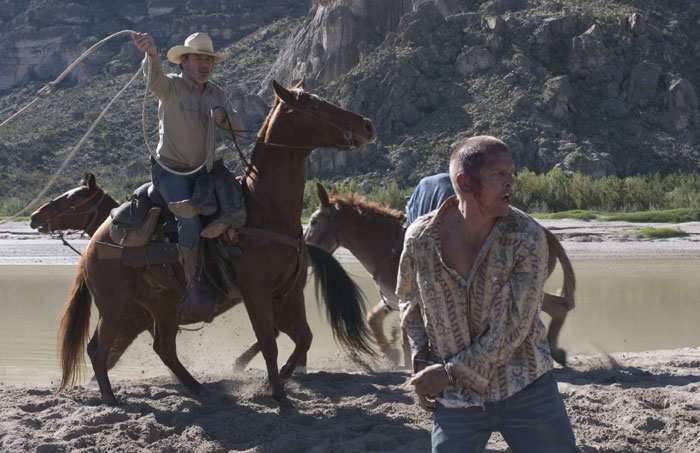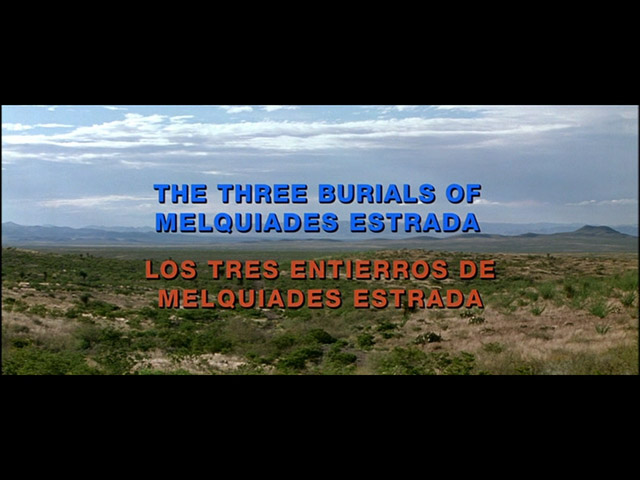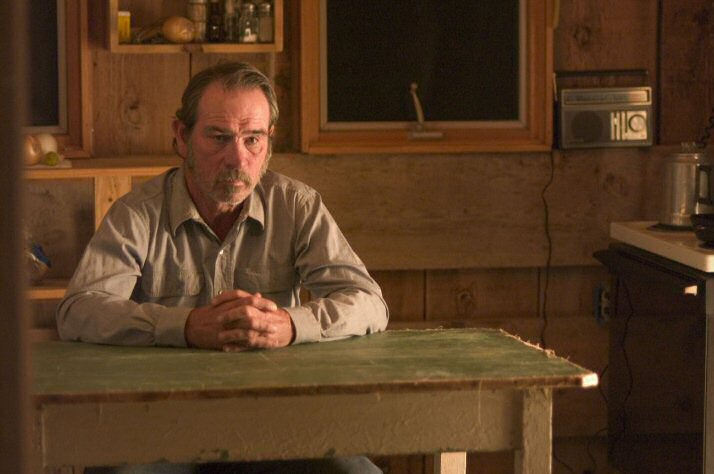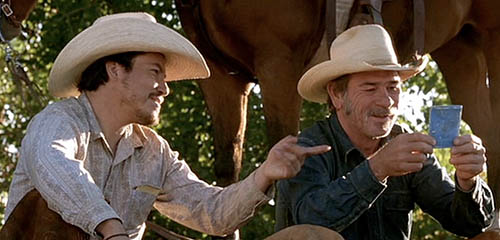This appeared in the Chicago Reader‘s February 3, 2006 issue. Tommy Lee Jones’ subsequent feature, The Homesman, confirms the talent, originality, and boldness of Jones as a director, even if it may also come across at certain junctures as less lucid than its predecessor. — J.R.
The Three Burials of Melquiades Estrada
**** (Masterpiece)
Directed by Tommy Lee Jones
Written bu Guillermo Arriaga
With Jones, Barry Pepper, Julio Cesar Cedillo, Dwight Yoakam, January Jones, and Melissa Leo
At last year’s Cannes film festival, The Three Burials of Melquiades Estrada walked off with the prizes for best actor (Tommy Lee Jones) and best screenplay (Guillermo Arriaga). It’s often hard to disentangle story, acting, and direction when they’re working together as well as they are here, but I would have honored Jones for his direction. That prize went to Michael Haneke for Caché, his eighth theatrical feature. This is Jones’s first, though he directed (and cowrote and starred in) a made-for-TV western, the 1995 The Good Old Boys.
Both Haneke’s and Jones’s films are political. The Three Burials of Melquiades Estrada, a western, protests the abusive treatment of Mexican immigrants in west Texas, and Caché, an anxiety-ridden crime thriller, protests the abusive treatment of Algerians in France. But Jones appears to trust narrative as a way to enlightenment, and Haneke doesn’t. And Jones’s direction offers more traditional virtues — his handling of landscapes and ‘Scope is especially impressive, thanks in part to cinematographer Chris Menges — though his list of some of his visual influences is fascinatingly eclectic: “the Kabuki Theatre, the art of Donald Judd and Dan Flavin, and the films of Akira Kurosawa, Sam Peckinpah, and Jean-Luc Godard.”
Arriaga’s screenplay, developed with Jones’s input, scrambles chronology as systematically as his script for 21 Grams did. It’s also full of macabre black comedy, recalling William Faulkner’s As I Lay Dying in the attempts of Pete Perkins, a bilingual ranch foreman, to fulfill the wish of his dead Mexican employee and friend Melquiades Estrada to be buried “back home,” which entails transporting his rotting corpse over enormous distances and through numerous ordeals. Jones’s portrait of Perkins, a fanatical and proudly ornery character, is as focused as his Oscar-winning performance as a U.S. marshal in The Fugitive (1993), which makes me wonder whether, as often happens with the Oscars, the Cannes jury was merely playing catch-up — rewarding Jones and Arriaga for the kind of work they’d done before while overlooking their more original work.
The story of The Three Burials of Melquiades Estrada was inspired by the unpunished 1997 murder of 18-year-old Ezequiel Hernandez Jr. in Texas by U.S. marines searching the border for drug smugglers. The careless, accidental murder of Melquiades Estrada (Julio Cesar Cedillo), an illegal immigrant, is committed by a border patrolman named Mike Norton (Barry Pepper), who’s recently arrived from Cincinnati with his wife, Lou Ann (January Jones). The press materials may exaggerate in calling him psychotic, but given the callously alienated way he has sex with Lou Ann — in contrast to the jubilant (if adulterous) sexual behavior of Perkins and Estrada — it’s obvious he’s plenty screwed up. (The movie mocks both bad sex and bad American TV, bringing them together in one scene with the Nortons.) Early on he’s shown behaving in a hostile manner toward Mexicans, and the shooting occurs while he’s supposed to be patrolling the border, when the sound of distant gunshots — Estrada trying to shoot a coyote — interrupts his plan to jerk off with a copy of Hustler.
The local sheriff (Dwight Yoakam) promptly buries Estrada without bothering to tell Perkins. After it becomes clear that the sheriff has no intention of investigating the murder, Perkins discovers from a truck- stop waitress named Rachel (Melissa Leo) — a married woman both he and the sheriff are sleeping with — that Norton was responsible. Perkins kidnaps Norton at gunpoint, forces him to dig up Estrada’s corpse, and drags both on a mock-epic journey back to Estrada’s remote homestead, where Estrada hadn’t been for at least five years.
There are elements in The Three Burials of Melquiades Estrada that I tend to distrust when they crop up in other movies. There’s the theme of redemption, which can all too easily lead to a Hollywood cop-out, even (or maybe especially) when it’s tied to some notion of religious transcendence. There’s the taken-for-granted dysfunctional social context, and there’s the visceral macho unpleasantness, which feels dishonest in movies such as Henri-Georges Clouzot’s The Wages of Fear (1953) and Peckinpah’s The Wild Bunch (1969) and Bring Me the Head of Alfredo Garcia (1974). I have to admit I still like those three films a lot, and I suspect that what I appreciate most in this movie is the nuance Jones gives these and other shopworn notions.
He explicitly signals the redemption theme when Lou Ann describes her husband to Rachel as “beyond redemption.” But any sense of it at the end of the movie is ironic and slightly comic, and it’s undermined earlier when a blind man asks Perkins to kill him as a favor, believing that committing suicide would “offend God.” Perkins tartly refuses his request, implicitly throwing the ethical dilemma into our laps.
Jones leaves social and family skills almost entirely out: Perkins seems capable of being sexually comfortable with Rachel only because they hardly ever talk — his cluelessness when he calls her from Mexico leads to an unforeseeable turnaround — and all the characters, even Estrada’s widow, seem to see sexual betrayal as an everyday fact of existence. But Jones also makes much of the rapport in the same-sex friendships, including one between Lou Ann and Rachel.
Jones sometimes seems to revel in the visceral unpleasantness, showing Perkins forcing Norton to siphon antifreeze into Estrada’s corpse in an attempt to preserve it and a vengeful Mexican woman pouring hot coffee on Norton’s already wounded leg. But the characters are so complexly imagined we can’t comfortably judge them or feel any moral certainty about who they are. We can’t even know for sure who the film’s leading character is — there are at least three candidates. All this edginess, combined with the grandeur and sweep of a classic western, demonstrates that Jones clearly knows how to tell a story — and how to confound us at the same time.







